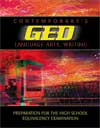 |  Contemporary's GED Language Arts, Writing Ellen Carley Frechette
Tim Collins
Sentence Basics
Chapter OutlineStudy the chapter outline below. Use the page numbers below each topic to refer to the corresponding section in Contemporary's GED Language Arts, Writing. When you are finished, go to the Flashcards or choose a different activity or chapter from the menu on the left.
Parts of a Sentence
(See pages 19–25)
A group of words must pass three tests in order to be called a sentence:
-
It must contain a subject, which tells you whom or what the sentence is about.
-
It must contain a predicate, which tells you what the subject is or does. The verb is the key word in the predicate.
-
It must express a complete thought.
|
 |  |  | Nouns
(See pages 32–37)
-
A noun is a word that labels a person, place, thing, or idea.
-
A plural noun names more than one person, place, thing, or idea.
-
A proper noun names a specific person, place, thing, or idea and begins with a capital letter.
-
A possessive noun shows ownership. An apostrophe (‘) and an -s are used to form the possessive.
|
 |  |  | Pronouns
(See pages 38–42)
Pronouns can replace nouns, making writing less repetitive.
-
A pronoun may be a subject (I, you, he, she, it, we, they, who) or an object (me, you, him, her, it, us, them, whom).
-
A possessive pronoun may stand alone (mine, yours, his, hers, ours, theirs, whose) or accompany a noun (my, your, his, her, its, our, their, whose).
-
In compounds of a noun and a pronoun, it can be hard to figure out whether to use a subject pronoun or an object pronoun. To make it easier, cross out the noun.
|
|



 2002 McGraw-Hill Higher Education
2002 McGraw-Hill Higher Education